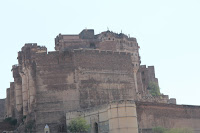It's Eco Fashion Week in Vancouver and given my interest in all things "Eco", I wanted to stop by and explore what fashion trends were coming for 2012FW. The show includes presentations from Nicole Bridger, Jeff Garner (Prophetik), Melissa Ferreira, who are pioneers in Eco Fashion, and fashion favorites such as, Jason Matlo. Since wearable fashion trends transcend into home fashion, it's important to see what's cooking in their world.
I had the opportunity to attend the press conference and panel discussion held at the opening of Eco Fashion Week. There were many interesting questions posed to the panel and here are some key takeaways that can be applied to the home textiles industry and to some extent, our personal lives:
All of the above points resonated with what we try to implement in the production of our Rajboori collection. We produce only enough to reduce waste and our designs use colors that are used all through a collection, making the collection easy to mix and match and coordinate harmoniously. The dyes we use are azo-free or vegetable, hence reducing use of chemicals in the process.
Silk, especially, Peace Silk, is more expensive to produce but at a consumer level it is an investment worth making as our quilts, coverlets, or pillows will last a lifetime, offering better return on investment to the consumer.
I hope more people come to the show and educate themselves on how to make more eco-friendly choices when it comes to fashion.
 |
| Melissa Ferreira, Jason Matlo, Nicole Bridger, Misty Greer |
- All the designers on the panel mentioned how they try to minimize waste involved in producing their collections.
- Designers try to re-purpose the waste or donate to someone who can give it new life by creating other products, such a as accessories.
- They all produce their collection locally, reducing carbon footprint
- It's more expensive to produce eco fashion but once a consumer makes the commitment to purchase a Designer label that is Eco and sustainable, that consumer knows that the piece will last a lifetime. The longevity of natural fibers, such as, silk, linen, tencel, and spandex added to such fibers is much higher and in the end, we end up wearing the favorite Eco dress for many seasons, thus maximizing the return on the initial investment and causing less waste.
 |
| Nicole Bridger |
All of the above points resonated with what we try to implement in the production of our Rajboori collection. We produce only enough to reduce waste and our designs use colors that are used all through a collection, making the collection easy to mix and match and coordinate harmoniously. The dyes we use are azo-free or vegetable, hence reducing use of chemicals in the process.
Silk, especially, Peace Silk, is more expensive to produce but at a consumer level it is an investment worth making as our quilts, coverlets, or pillows will last a lifetime, offering better return on investment to the consumer.
I hope more people come to the show and educate themselves on how to make more eco-friendly choices when it comes to fashion.






















































